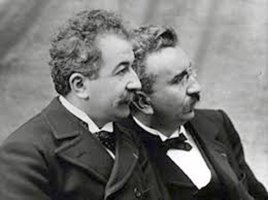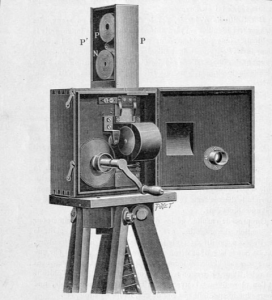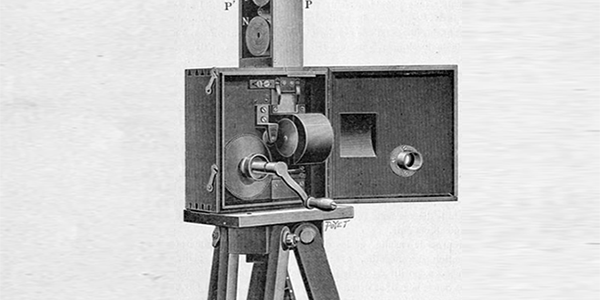
© Wikicommons
The film industry, as we know it today, owes its existence to numerous inventors, visionaries, and technological advancements throughout history. One of the most crucial milestones in this evolution was the creation of the Cinematograph by the Lumière Brothers in 1895. The Cinematograph, a revolutionary combination of camera, film processing, and projection system, paved the way for the first public screenings of motion pictures. This article delves into the significance of the Lumière Brothers’ invention and its profound impact on the foundation and growth of the film industry.
The Lumière Brothers: Pioneers of Cinema
- Background and Early Ventures Born in France, Louis and Auguste Lumière were two of the earliest filmmakers and inventors who played a seminal role in shaping the film industry. The Lumière Brothers hailed from a family involved in photography, which influenced their interest in the field.
- The Cinematograph: Birth of a Technological Marvel In 1895, the Lumière Brothers unveiled their groundbreaking invention, the Cinematograph. It combined the functionalities of a camera, film processor, and projection system, marking a significant advancement in the history of motion pictures. The Cinematograph enabled the Lumière Brothers to capture moving images, process the film, and project it onto a screen for public viewing.

© Wikicommons
The Impact of the Cinematograph on the Film Industry
- Public Screenings and the Birth of Cinema The Lumière Brothers’ Cinematograph facilitated the first public screenings of motion pictures, marking the birth of cinema as a popular medium of entertainment. Their inaugural public screening took place in Paris on December 28, 1895, at the Salon Indien du Grand Café, astounding audiences with the magic of moving images.
- Expansion of Film Culture and Industry The Cinematograph’s success propelled the rapid expansion of film culture and the birth of the film industry. The Lumière Brothers’ invention sparked a global interest in motion pictures, leading to the establishment of numerous movie theaters and the emergence of a burgeoning film market.
- Influence on Filmmaking Techniques and Aesthetics The Lumière Brothers’ Cinematograph revolutionized filmmaking techniques and aesthetics. The ability to capture and project moving images influenced directors and cinematographers to experiment with storytelling, composition, lighting, and camera movements. The Cinematograph’s mobility enabled filmmakers to capture scenes outside traditional studio environments, expanding the possibilities of visual storytelling.
Legacy and Continuing Influence
- Technological Advancements and Innovations The Cinematograph paved the way for subsequent technological advancements in the film industry. Innovations such as synchronized sound, color film, special effects, and digital filmmaking owe their roots to the Lumière Brothers’ invention.
- Cinematic Language and Narrative Development The Lumière Brothers’ Cinematograph contributed to the development of cinematic language and narrative techniques. As filmmakers explored the possibilities of this new medium, they developed storytelling conventions, editing techniques, and narrative structures that continue to shape contemporary filmmaking.
The Lumière Brothers’ invention of the Cinematograph in 1895 revolutionized the film industry, allowing for the first public screenings of motion pictures. This technological breakthrough laid the foundation for cinema as a popular medium of entertainment and paved the way for the rapid growth and evolution of the film industry. The Cinematograph’s impact on filmmaking techniques, aesthetics, and narrative development continues to be felt to this day. The Lumière Brothers’ legacy as pioneers of cinema and their groundbreaking invention continues to inspire filmmakers and artists worldwide. Their visionary creation, the Cinematograph, stands as a testament to the power of human innovation and the enduring magic of moving images.
Footnotes:
- Lumière, Louis. “The Lumière Cinematograph: A New Process of Photography.” The Photographic Journal, vol. 36, no. 1, 1896, pp. 17-23.
- Musser, Charles. “The Lumière Cinématographe: A Contribution to the Pre-History of Cinema.” Film History, vol. 1, no. 1, 1987, pp. 19-30.
- Gunning, Tom. “An Aesthetic of Astonishment: Early Film and the (In)credulous Spectator.” Art and Text, no. 34, 1989, pp. 31-45.
- Elsaesser, Thomas. “Cinema, the Lumière Legacy, and the Digital Challenge.” Film History, vol. 18, no. 1, 2006, pp. 22-37.
- Burch, Noël. “The Lumière Cinematograph.” A Short History of Film, Princeton University Press, 1986, pp. 20-25.


